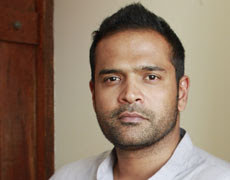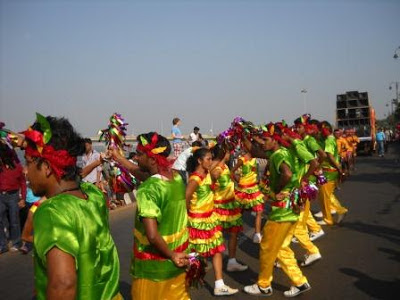Hello everybody,
Thank you for all the wonderful comments on the last post. Glad to know some "Anonymous" readers found it informative. The following post has long been due. Meant to do this much earlier but have been somewhat restricted by the sudden and very painful onset of osteo-arthritis in my right knee.
Thank you for all the wonderful comments on the last post. Glad to know some "Anonymous" readers found it informative. The following post has long been due. Meant to do this much earlier but have been somewhat restricted by the sudden and very painful onset of osteo-arthritis in my right knee.
Joe and I visited north Goa early December last year. He visits Divar Island at least thrice a
year. It was my first time.
We took the
night train from Mumbai and arrived Karmali Station, Goa, at around 10.30 am
the next day.
We took a taxi to the Old Goa jetty to take the ferry. There’s one every 10 mns. and its free for
passengers. Vehicles are charged Rs. 10
one way. The crossing takes about 5
minutes
Languidly beautiful Divar is situated across the Mandovi
River. This island is linked to Old Goa
on its south eastern side and Ribandar on its south western side by ferry. Ribandar is where Joe was born and the hospital itself faces the Mandovi River.
Now, this photo was taken to show the endearing "dress code" (behind me) which appears not to have changed since I was ten years old.
Local buses ply inland. If the driver sees an approaching ferry, he waits. Otherwise you may have to wait a long time to take the next one.
We stayed in the picturesque village of Piedade which spreads
at the bottom of a small wooded hillock. There is nothing here but paddy fields, stately homes and peace and quiet.
A wide track leads to the top of the hill where the 16th
century Church of Our Lady of Compassion stands. Joe had gone up the hill that morning and he
was so impatient for me to see the church even though it was dusk. It
took huffing puffing me about 10 minutes to reach the top. It’s not steep and also motorable. The sacristan
who lived in a lodge nearby was kind enough to unlock and open the doors for us
so we could take pictures. The interiors
of the church are fabulous. He even switched on all the lights and here are the
photos we took.
We were told this spot once offered great views of the Old Goa churches. Now, due to growing vegetation, we were unable to take in a panoramic sight.
Then there's the beautiful temple complex right next to the
church. So typical of Goa. Churches and temples existing harmoniously side by side. Here too the young priest was
very enthusiastic. He urged us to go in
and take pictures. Normally he said, the temples would have been shut. That particular night was new moon night and
they were having an “aarti” ceremony. We
also met two smiling, young, Hindu women who had come to pray. They gave us a brief history of the place. During
the time of the Kadamba dynasty, on this site there existed an ancient Ganesh
Temple. The Church is situated at the site of an ancient Hindu temple which is
known to have been destroyed in the late 15th century by the Muslims. To one side is a small, walled cemetery which
is known to have been converted from the former Hindu shrine, a Ganesh Temple, which
was razed by the Portuguese. The deity
was later shifted to its present site at Candola.
The Ganesh Temple
The Ganesh Temple
The people of Divar are very friendly and helpful as long as you've come there for a quiet holiday. They are opposed to anything that will spoil the landscape. May it always stay that way.
We were rather intrigued by this sleeping figure of Christ the Redeemer that lies within the chapel. Isn't the casket gorgeous ?
Sr. Jisha of the Brigettine Sisters with some of the Divar kids at the convent's day care.
There's also a bakery which has a delectable collection of cakes, pastries and Goan sweets which are made at home by the local ladies and sold in this shop.
murals in a local pub
Three things that make up a typical Goan. (Feni is the local brew)
The popular Bonderam festival is celebrated in Divar on every 4th Saturday in the month of August during the monsoon, with great fanfare. The festival is attended by both locals and tourists.
No prizes for guessing who is a regular.
Bonderam (Festival of flags). Portuguese flag included !
Catholic procession to the paddy fields. The priest symbolically cuts the first sheaf of grain. It's harvest time.
The Potekar festival is also held 3 days before the beginning of Ash Wednesday. This is when the local youth wear costumes, masks and cow bells. They roam around the village demanding drinks and snacks from the locals.
There is also a resort on the island - tucked away in a corner.























































